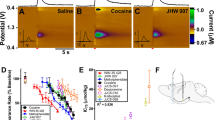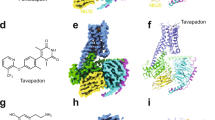Abstract
Postsynaptic dopamine (DA) receptors have been classified biochemically and pharmacologically into two types: D-1 receptors mediate adenylate cyclase stimulation, demonstrating micromolar affinity for DA and butyrophenone antagonists; D-2 receptors mediate adenylate cyclase inhibition, demonstrating nanomolar affinity for DA and butyrophenone antagonists1,2. D-1 receptors are labelled by 3H-thioxanthene antagonists2,3, while D-2 receptors are labelled by both 3H-agonists and all 3H-antagonists2,4. A third class of dopaminergic binding site, termed D-3, represents high-affinity 3H-agonist binding sites demonstrating low, micromolar, affinity for butyrophenones5,6. In the rat striatum, D-3 sites were decreased 50% by 6-hydroxy dopamine (6-OHDA) lesions of the nigrostriatal DA pathway7–9, suggesting that such D-3 binding labels presynaptic DA autoreceptors on nigrostriatal terminals5,7–9. However, nigrostriatal denervation produces a concomitant depletion of striatal DA10,11. Here we demonstrate that a reserpine-induced depletion of DA produces a decrease in D-3 binding comparable to that seen with nigrostriatal denervation, independent of presynaptic terminal degeneration. This loss in binding, or that caused by 6-OHDA lesions, is recovered by preincubating the striatal membranes with DA or with the supernatant from control striatal membrane preparations. We therefore suggest that the loss of D-3 binding following 6-OHDA lesions results from the depletion of endogenous DA rather than the degeneration of terminals and their putatively associated autoreceptors.
This is a preview of subscription content, access via your institution
Access options
Similar content being viewed by others
References
Kebabian, J. W. & Calne, D. B. Nature 277, 93–96 (1979).
Creese, I., Sibley, D. R., Hamblin, M. W. & Leff, S. E. A. Rev. Neurosci. 6, 43–71 (1983).
Hyttel, J. Life Sci. 23, 551–556 (1978).
Hamblin, M. W. & Creese, I. Life Sci. 30, 1587–1595 (1982).
Seeman, P. Pharmac. Rev. 32, 229–313 (1980).
Titeler, M., List, S. & Seeman, P. Commun. Psychopharmac. 3, 411–420 (1979).
Nagy, J. I., Lee, T., Seeman, P. & Fibiger, H. C. Nature 278, 577–578 (1978).
Sokoloff, P., Martres, M.-P. & Schwartz, J.-C. Nature 288, 283–286 (1980).
Sokoloff, P., Martres, M.-P. & Schwartz, J.-C. Naunyn-Schmiedeberg's Archs Pharmak 315, 89–102 (1980).
Ungerstedt, U. in 6-Hydroxydopamine and Catecholamine Neurones (eds Malmfors, T. & Thoenen, H.) 101–127 (North-Holland, Amsterdam, 1971).
Koslowski, M. R., Sawyer, S. & Marshall, J. F. Nature 287, 52–54 (1980).
Munson, P. J. & Rodbard, D. Analyt. Biochem. 107, 220–239 (1980).
Sibley, D. R., De Lean, A. & Creese, I. J. biol Chem. 257, 6351–6361 (1982).
Bacopoulos, N. G. Life Sci. 29, 2407–2414 (1981).
Lad, P. M., Nielsen, T. B., Preston, M. S. & Rodbell, M. J. biol. Chem. 255, 988–995 (1980).
Lefkowitz, R. J. & Williams, L. T. Proc. natn. Acad. Sci. U.S.A. 74, 515–519 (1977).
Williams, L. T. & Lefkowitz, R. J. J. biol. Chem. 252, 7207–7209 (1977).
Sibley, D. R., Leff, S. E. & Creese, I. Life Sci. 31, 637–645 (1983).
Nagatsu, T., Levitt, M. & Udenfriend, S. Analyt. Biochem. 9, 127–132 (1964).
Knapp, S., Mandell, A. J. & Bullard, W. P. Life Sci. 16, 1583–1594 (1975).
Author information
Authors and Affiliations
Rights and permissions
About this article
Cite this article
Leff, S., Creese, I. Dopaminergic D-3 binding sites are not presynaptic autoreceptors. Nature 306, 586–589 (1983). https://doi.org/10.1038/306586a0
Received:
Accepted:
Issue Date:
DOI: https://doi.org/10.1038/306586a0
Comments
By submitting a comment you agree to abide by our Terms and Community Guidelines. If you find something abusive or that does not comply with our terms or guidelines please flag it as inappropriate.



